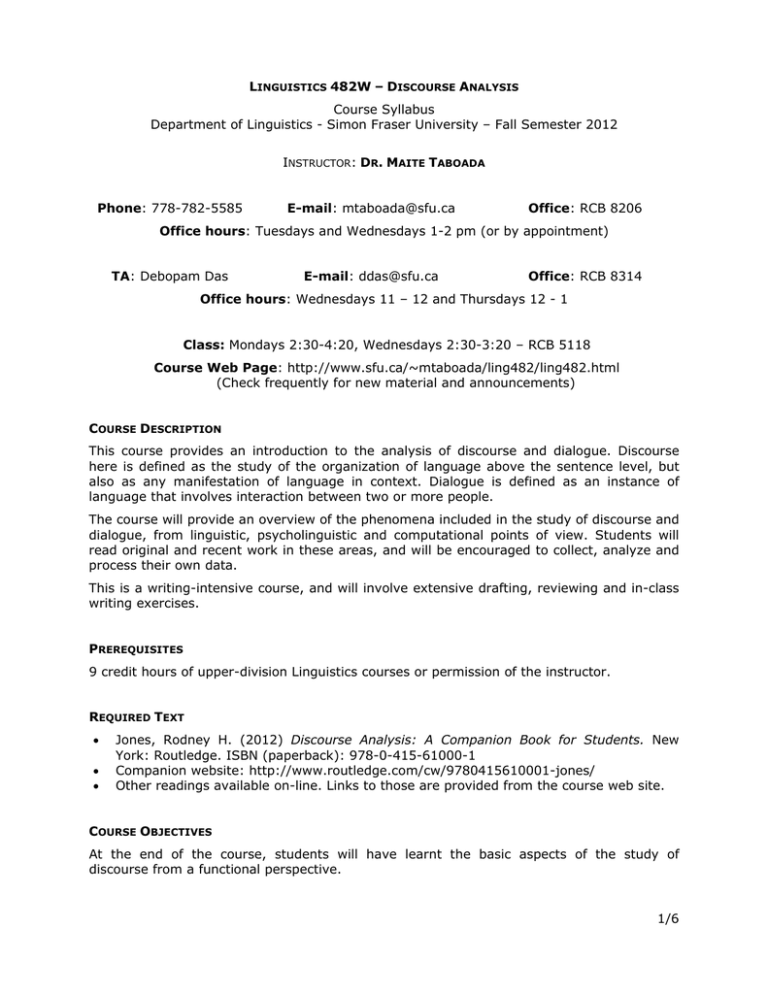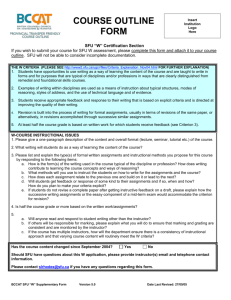Course Syllabus I
advertisement

LINGUISTICS 482W – DISCOURSE ANALYSIS Course Syllabus Department of Linguistics - Simon Fraser University – Fall Semester 2012 INSTRUCTOR: DR. MAITE TABOADA Phone: 778-782-5585 E-mail: mtaboada@sfu.ca Office: RCB 8206 Office hours: Tuesdays and Wednesdays 1-2 pm (or by appointment) TA: Debopam Das E-mail: ddas@sfu.ca Office: RCB 8314 Office hours: Wednesdays 11 – 12 and Thursdays 12 - 1 Class: Mondays 2:30-4:20, Wednesdays 2:30-3:20 – RCB 5118 Course Web Page: http://www.sfu.ca/~mtaboada/ling482/ling482.html (Check frequently for new material and announcements) COURSE DESCRIPTION This course provides an introduction to the analysis of discourse and dialogue. Discourse here is defined as the study of the organization of language above the sentence level, but also as any manifestation of language in context. Dialogue is defined as an instance of language that involves interaction between two or more people. The course will provide an overview of the phenomena included in the study of discourse and dialogue, from linguistic, psycholinguistic and computational points of view. Students will read original and recent work in these areas, and will be encouraged to collect, analyze and process their own data. This is a writing-intensive course, and will involve extensive drafting, reviewing and in-class writing exercises. PREREQUISITES 9 credit hours of upper-division Linguistics courses or permission of the instructor. REQUIRED TEXT • • • Jones, Rodney H. (2012) Discourse Analysis: A Companion Book for Students. New York: Routledge. ISBN (paperback): 978-0-415-61000-1 Companion website: http://www.routledge.com/cw/9780415610001-jones/ Other readings available on-line. Links to those are provided from the course web site. COURSE OBJECTIVES At the end of the course, students will have learnt the basic aspects of the study of discourse from a functional perspective. 1/6 LING 482W SYLLABUS Assignments and final papers will involve analyses of texts from different perspectives. The emphasis is on the identification of patterns and labelling of text structures. The ultimate goal of the assignments is to be able to write a descriptive account of the analysis, and to explain how discourse analysis contributes to a better understanding of language phenomena. The course will use writing as a means of learning. Writing will consist of informal and formal assignments, some of them in-class and in group (in-class short essays, reports, reading logs, peer evaluation, etc.). There will also be a final paper, for which a preliminary draft and an in-class presentation are required. Note that this is neither a remedial course nor one suitable for students seeking ESL writing instruction. The course will foster the ability to write; it will not teach basic writing skills. An excellent command of the English language is expected. COURSE EXPECTATIONS 1. Students are expected to attend all classes and to arrive on time so that classes may begin promptly. Announcements will be made at the beginning and end of classes regarding the assigned readings and the expectations for exams. 2. Students are expected to have read all assigned readings before class. Because many students will be learning about a new field of study, some of the materials and concepts may seem fairly complex. You should probably read assigned readings and go over the lecture notes multiple times. 3. It is very important for students to participate in class discussions. Therefore, everyone must come to class prepared. Preparation includes carefully reading of the assigned material, noting any questions that you have, and thinking of how the reading relates to your own personal experiences. 4. Students will be responsible for all materials covered in the assigned readings and lectures. 5. Assignments are due at the beginning of class. Late assignments will not be accepted. 6. Students will be respectful of other students and the instructor. In particular, students will not talk while the instructor or another student is talking. 7. Students should familiarize themselves with the Department’s Standards on Class Management and Student Responsibilities at: http://www.sfu.ca/linguistics/undergraduate/student-resources/departmentstandards.html 8. Cell phones: please make sure that your cell phone (or any other noisy device, including alarms) is turned off during class. 9. Academic dishonesty in all forms violates the basic principles of integrity and thus impedes learning. More specifically, academic dishonesty is a form of misconduct that is subject to disciplinary action and includes the following: cheating, fabrication, fraud, facilitating academic dishonesty, and plagiarism. For more information on academic honesty and student conduct, please visit the following websites: http://students.sfu.ca/calendar/student-info/academic-honesty.html http://www.sfu.ca/policies/gazette/teaching.html Please complete the library’s plagiarism tutorials: 2/6 LING 482W SYLLABUS http://www.lib.sfu.ca/help/tutorials/plagiarism-tutorial A grade of “FD” may be assigned as a penalty for academic dishonesty. Tutors, editors, or any other types of outside help are not allowed. Exceptions are the assistance provided through the Student Learning Commons (see below, under Resources). 10. Please note that students requiring accommodations as a result of a disability must contact the Center for Students with Disabilities (778-782-3112 or csdo@sfu.ca). 11. All student requests for accommodation for religious practices must be made in writing by the end of the first week of classes or no later than one week after a student adds a course. E-MAIL POLICY You are welcome to submit questions and comments via e-mail. Please keep the following in mind when sending your message. 1. I cannot always respond to messages late in the evening or on weekends. If you send a message late on Friday or during the weekend, I might not reply until the following week. 2. I can only respond to questions that can be answered in a sentence or two. Questions requiring longer replies should be asked in class or during office hours. 3. Please proof-read your e-mail message to make sure that your question is clear. In addition, I would appreciate questions that are expressed in an appropriately polite manner. 4. Please always sign your name and the course number. Make sure the Subject line contains the name of the course (“Ling 482”). Anonymous messages will not be answered. Further, if your message does not clearly address the content of the course, or the Subject line is simply “hi”, there is a good chance that it will be automatically classified as spam, and discarded before I actually get to see it. 5. Because of the large number of e-mail messages that I receive, it may be several days before I am able to reply to your message. It is often easier and faster to ask a question in class or during office hours. I may also provide answers in class, instead of replying to individual e-mail messages. COURSE GRADE The final grade will be calculated according to the percentages below. The participation grade includes attending class regularly and participating actively. Other in-class activities (written questions about the reading, reading logs, reports, group work) will also count towards your participation grade. There will be 3 or 4 assignments, a presentation in class and a final paper. More detail on each of these will be provided throughout the semester. COMPONENT WEIGHT Participation 10% Assignments 35% Class presentation 15% Final paper 40% 3/6 LING 482W SYLLABUS Percentage scores on assignments and other course components will be based on objective criteria. Final letter course grades will be computed from percentage scores on all the course components. The following table provides a rough estimate of grade breakdowns for the final grade. Due attention will be given to the verbal descriptions listed below. There is no university-wide standard scale. An instructor adopts a grade scale appropriate to the level and content of the course. 96-100% A+ 91-95% A 86-90% A- 81-85% B+ 76-80% B 71-75% B- Extraordinary performance Excellent performance Good performance 66-70% C+ Satisfactory performance 61-65% C 56-60% C- 50-55% D < 50% F Marginal performance Unsatisfactory performance (fail) GRADE APPEALS If a student wishes to contest the marking of an exam, assignment or paper, the instructor can agree to remark his/her entire exam at the instructor's convenience and not in front of the student. A grade reconsideration may raise the grade, lower the grade, or leave the grade unchanged, as stated in Policy T20.01, clause 2.4.4. The only reason a grade change will be made is if there is an arithmetic error or if it has been determined that the exam, assignment or paper deserves a lower grade or a higher grade after it has been remarked. The following are not reasons for reconsideration of a grade: • The student is on probation. • The student wants to get into Business or any other program. • The student worked hard and thinks this should be a factor. • The student does not like the grade scale. • The student’s score is x% below the next grade and would like the instructor to ignore the difference. RESOURCES A number of resources are available to the students in the class. The SFU Learning Commons is available to all SFU students, and provides assistance with learning, academic writing and reading strategies (http://learningcommons.sfu.ca/). The course web page also lists a number of website and resources. Please check it frequently, and make sure you avail yourself of all the tools that you may need. 4/6 LING 482W SYLLABUS TOPICS AND READINGS The following list is subject to change, depending on students’ interests. These are suggestions, and students are encouraged to consult other readings, especially when preparing for assignments, presentations and papers. Note also that readings may be added; you should always consult the web version of the syllabus and schedule. INTRODUCTION • Textbook, Part A (pp. 1-34) DISCOURSE DATA • Du Bois, John W., Stephan Schuetze-Coburn, Susanna Cumming and Danae Paolino. (1993). Outline of discourse transcription. In J. A. Edwards and M. D. Lampert (Eds.), Talking Data: Transcription and Coding in Discourse Research. Hillsdale, NJ: Lawrence Erlbaum. (pp. 45-89). COHESION AND COHERENCE • Textbook, Unit 2 (Parts A, B, C and D) • Mann, William C. and Sandra A. Thompson. (1988). Rhetorical Structure Theory: Toward a functional theory of text organization. Text, 8(3), 243-281. • Fraser, Bruce (1999) What are discourse markers? Journal of Pragmatics 31. 931-952. GENRES AND REGISTERS; WRITTEN AND SPOKEN LANGUAGE • Textbook, Unit 3 (Parts A, B, C and D) • Eggins, Suzanne. (2004). An Introduction to Systemic Functional Linguistics. London: Continuum. Chapters 3 and 4. Genre: Context of culture in text and Register: Context of situation in text (pp. 54-112). • Crystal, David. (1995). Speech and writing. The Cambridge Encyclopedia of the English Language. Cambridge: Cambridge University Press. (pp. 291-293). IDEOLOGY • Textbook, Unit 4 (Parts A, B, C and D) SPOKEN INTERACTION, SPEECH ACTS • Textbook, Unit 5 (Parts A, B, C and D) • Mey, Jacob L. (2001). Pragmatics: An Introduction (2nd ed.). Malden, Mass: Blackwell. Chapter 3. Context, implicature and reference. (pp. 39-66). • Sadock, Jerrold. (2004). Speech acts. In L. R. Horn and G. Ward (Eds.), The Handbook of Pragmatics (pp. 53-73). Malden, MA: Blackwell. • Sacks, Harvey, Emmanuel Schegloff and Gail Jefferson. (1974). A simplest systematics for the organization of turn-taking in conversation. Language, 50, 696-735. CONVERSATIONAL STRATEGIES • Textbook, Unit 6 (Parts A, B, C and D) • Brown, Penelope and Stephen C. Levinson. (1999 [1987]). Politeness: Some universals in language usage. In A. Jaworski and N. Coupland (eds.) The Discourse Reader. London: Routledge. (pp. 321-335). 5/6 LING 482W SYLLABUS CONTEXT • Textbook, Unit 7 (Parts A, B, C and D) • Re-read: Eggins, Suzanne. (2004). An Introduction to Systemic Functional Linguistics. London: Continuum. Chapters 3 and 4. Genre: Context of culture in text and Register: Context of situation in text (pp. 54-112). MEDIATED DISCOURSE ANALYSIS • Textbook, Unit 8 (Parts A, B, C and D) MULTIMODALITY • Textbook, Unit 9 (Parts A, B, C and D) CORPUS-ASSISTED DISCOURSE ANALYSIS • Textbook, Unit 10 (Parts A, B, C and D) 6/6




